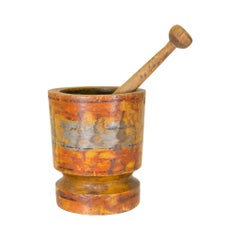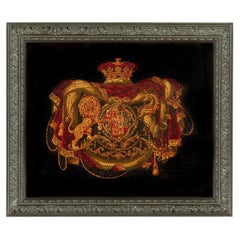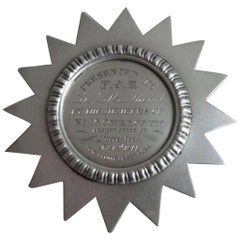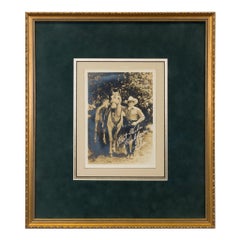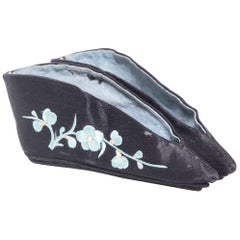19th Century Historical Memorabilia
to
74
280
203
499
71
21
10
10
7
6
5
4
3
2
1
1
113
499
1,166
29
343
475
193
39
42
36
63
49
76
123
83
45
25
203
139
83
59
55
265
149
140
105
80
499
499
499
6
3
2
2
1
Period: 19th Century
19th Century Mortar and Pestle
Located in Coeur d'Alene, ID
19th century fruitwood mortar and pestle. Remnants of oxblood red and silver blue banded paint. Original pestle included.
Origin: Eastern, United States
Period: First half of the 19...
Category
American Antique 19th Century Historical Memorabilia
Materials
Fruitwood
Queen Adelaide’s Coach Panels
Located in Lymington, Hampshire
These two wood panels are of rectangular form, one with rounded corners. Each is painted with a large Royal coat of arms flanked by a lion and a unicorn surmounted by a queen’s crown and red velvet mantling trimmed...
Category
English Antique 19th Century Historical Memorabilia
Materials
Wood
Pair of Signed Antique Repouse Metal Wall Plaques of Noble or Historical Men
Located in Hamilton, Ontario
This pair of antique wall plaques are possibly signed by an unknown artist, or identify the respective individuals in both, and are presumed to ori...
Category
English Victorian Antique 19th Century Historical Memorabilia
Materials
Metal
Fourteen Point Star Badge
By George Ward
Located in London, GB
A 14 point star Badge made by George Ward of Manchester and assayed in Chester in 1843
Engraved with "Presented to PCR George Heathcote by members of No...
Category
English Antique 19th Century Historical Memorabilia
Framed and Signed Photograph of Buck Jones
Located in Coeur d'Alene, ID
Matted and framed photo of Buck Jones with note "Best Wishes Buck Jones and Silver."
Period: Last half 19th century
Origin: California
Size: 5" x 7" frame 13" x 15"
Family Owned & Operated
Cisco’s Gallery deals in the rare, exceptional, and one-of-a-kind pieces that define the history of America and the Old West. Our pieces range from American Indian to Cowboy Western and include original items of everyday life, commerce, art, and warfare that tamed America’s frontier. Our 14,000 square foot gallery opened in 1996 in beautiful Coeur d’Alene, Idaho.
Personal Service
Cisco’s operates on old fashioned values – honesty and integrity, and all of our items are backed by our money back guarantee. We appreciate the opportunity to earn your business. Whether you desire assistance with a jewelry purchase, choosing a gift, identification, or even selling – we hope to be your trusted source.
Black and white, films...
Category
American Antique 19th Century Historical Memorabilia
Materials
Art Glass
Chinese Black Silk Lotus Slippers with Plum Blossoms, c. 1850
Located in Chicago, IL
These pointed slippers, beautifully embroidered with light blue plum blossoms on black silk, were shaped to resemble a lotus bud and enhanced the diminutive shape of bound feet. A practice that began in the Tang dynasty and reached the height of its popularity during the Qing dynasty, foot binding was a painful process intended to make a woman's feet as small as possible by restricting bone growth from an early age. The smaller the feet the more attractive and erotic they were, giving elite women a mark of elegance and a distinctive - albeit tortured - gait of small, light steps. These beautifully preserved lotus slippers...
Category
Chinese Qing Antique 19th Century Historical Memorabilia
Materials
Silk
Pair Chinese Double Luck Lotus Slippers, c. 1850
Located in Chicago, IL
These pointed silk slippers are beautifully embroidered with colorful bats and golden coins, symbols of happiness and good luck, and were shaped to resemble a lotus bud to enhance one's bound feet. A practice that began in the Tang dynasty and reached the height of its popularity during the Qing dynasty, foot binding was a painful process intended to make a woman's feet as small as possible by restricting bone growth from an early age. The smaller the feet the more attractive and erotic they were, giving elite women a mark of elegance and a distinctive, albeit tortured, gait of small, light steps. These beautifully preserved lotus slippers...
Category
Chinese Qing Antique 19th Century Historical Memorabilia
Materials
Fabric, Silk
Mail pouch in maroquin rouge, 19th century
Located in PARIS, FR
Red leather pouch to carry or deliver the mail with flap, decorated with gilt fleur-de-lys arabesques.
Interior, two pockets, and a smaller one with flap.
A folding gusset allows to ...
Category
French Napoleon III Antique 19th Century Historical Memorabilia
Materials
Leather
Audsley, George Ashdown and James, Lord Bowes ‘The Keramic Art of Japan’
By George Ashdown Audsley & James Lord Bowes
Located in Lymington, Hampshire
Audsley, George Ashdown and James, Lord Bowes ‘The Keramic Art of Japan’, Liverpool and London, Henry Sotheran, 1875. 2 volumes, first edition hardback folio including 41 coloured an...
Category
English Antique 19th Century Historical Memorabilia
Materials
Paper
A plaster military trophy panel from the Duke of Gordon’s house in Edinburgh
Located in Lymington, Hampshire
A plaster military trophy panel from the Duke of Gordon’s house in Edinburgh, the panel carved with a panoply including a shield, quiver, wrapped standard and sword, all within an oa...
Category
Scottish Antique 19th Century Historical Memorabilia
Materials
Plaster, Oak
19th Century Buffalo Wild Bill Cody Cabinet Collectors Card
Located in Coeur d'Alene, ID
Buffalo Bill's Wild West Hon. W.F. Cody cabinet card by Anderson 785 Broadway, New York.
Period: Late 19th century
Origin: New York
Size: 4 1/4" x 6"
Family Owned & Operated
Cisco’...
Category
Antique 19th Century Historical Memorabilia
Materials
Other
19th Century Solid Wood Coffee Table
By France"
Located in Madrid, ES
19th century solid wood coffee table.
Above it has a glass back
In the centre it has a brass pot for flowers.
Measures: 50 cm high and 110 c...
Category
French Modern Antique 19th Century Historical Memorabilia
Materials
Wood
Captain Sir George Collier’s Presentation Silver Entree Dishes by Richard Cooke
Located in Lymington, Hampshire
Captain Sir George Collier’s presentation silver entree dishes and covers by Richard Cooke, London 1803, each plain rectangular with gadroon borders, covers with detachable vine twist handles, the covers engraved: ‘Presented by the Old Madras Insurance Company to Captn. Collier, Commander of His Majestys Sloop ‘Victor’, for his persevering & gallant conduct in chasing for two days, partially engaging & ultimately sinking the French National Corvette ‘La Fleche’ of superior force while advantageously anchored at the Mahé Islands.’
Dimensions approx.: 150 x 290 x 200mm / 6 x 11 ½ x 8 inches
Total weight approx.: 3513 grams / 112 oz. troy.
Footnotes: These silver dishes were presented to Captain Sir George Collier KCB (1774-1824) for destroying the 22-gun French corvette La Flèche whilst commanding Victor, 18 guns, in the Seychelles on 5 September 1801. After escorting troop transports into the Red Sea ahead of the British invasion of Egypt, Victor fell in with La Flèche off Diego Garcia. After an initial engagement, the corvette escaped to windward only to be found again four days later. A short but fierce action ensued during which the corvette caught fire, grounded on a coral reef and sank before a prize crew could secure the ship. As reward, the Admiralty made Collier post captain and gave him command of Leopard, 50 guns.
Born in London, Collier entered the Royal Navy in 1784. As a midshipman, he was wrecked off Madagascar in 1792 surviving among the natives of that island for six months before being rescued by a passing Portuguese brig. Unfortunately, the brig was immediately captured by a French privateer and for two more years, Collier was confined as a prisoner of war on Mauritius. Returning to service in 1795, he was given his first command in Suffolk Tender.
Following the Peace of Amiens, Collier commanded the Sea Fencibles at Liverpool. After accompanying the expedition to Copenhagen in 1808, for which he was knighted for delivering the admiral’s dispatches, he saw action, and was wounded, supporting the military Campaign in Spain.
After the war, Collier was made commodore on the African station where he was employed suppressing the slave trade with such rigour that he was elected an honorary member of the African Institution, founded by William Wilberforce...
Category
British Antique 19th Century Historical Memorabilia
Materials
Silver
Ute Sheep Horn Spoon, circa 1870
Located in Coeur d'Alene, ID
Ute sheep horn spoon with old tag “Ute, Pine River, Battle, Ex. Cottchall Collection. Collected 1870.” Brain tanned with blue and white beading on top.
Per...
Category
American Native American Antique 19th Century Historical Memorabilia
Materials
Horn
19th Century Leather Quirt
Located in Coeur d'Alene, ID
Two-tone leather quirt with fringe drops. Shot filled handle.
Period: 19th century
Origin: Montana
Size: quirt 18" overall with flappers 33" plus wrist wrap.
Family ...
Category
American Antique 19th Century Historical Memorabilia
Materials
Leather
1891 Map of Norfolk County Massachusetts
Located in Norwell, MA
1891 map of Norfolk county Massachusetts including the towns of Wrentham, Franklin, Medfield, Sherborn, Norwood etc., measures: 23 x 31.
Category
Antique 19th Century Historical Memorabilia
Wilson Chilton’s mahogany Naval Architects/draughtsman box of curves/templates
Located in Lymington, Hampshire
Wilson Chilton’s mahogany Naval Architects/Naval draughtsman box of curves and templates, probably by Gillows still retaining around 100 superb quality...
Category
English Antique 19th Century Historical Memorabilia
Materials
Mahogany
19th Century Spanish Scoop or Plow of Wood and Iron with Rustic Farm Look
Located in Atlanta, GA
A 19th century Spanish scoop or plow of wood and iron. This antique farming tool from Spain features a wonderfully weathered wood scoop jointed w...
Category
Spanish Rustic Antique 19th Century Historical Memorabilia
Materials
Iron
1840 Campaign Kerchief of William Henry Harrison on Horseback
Located in York County, PA
1840 campaign kerchief featuring an image of William Henry Harrison on horseback in military garb, one of the first known campaign textiles in e...
Category
American Antique 19th Century Historical Memorabilia
Materials
Cotton
13 Star American Parade Flag with Rare Design, circa 1888 Ex Richard Pierce
Located in York County, PA
13 Star American parade flag in an extremely rare design, with “protection to home industries” slogan on a fanciful, scrolling streamer, made for the 1888 presidential campaign of Benjamin Harrison; formerly in the collection of Richard pierce.
1888 Benjamin Harrison campaign flag, printed on cotton, with 13 large stars in a 3-2-3-2-3 pattern, upon which a whimsical, scrolling streamer is superimposed that features the slogan: “Protection to Home Industries.”
There are numerous styles of both documented and undocumented, red, white, and blue bandanas and handkerchiefs, made for Harrison’s campaign in this year, as well as from the subsequent one, in 1892. Most bear variations of text to support the “Protection for American Industries” platform of the Republican Party. America was in the midst of the industrial age and there was a great deal of public interest, both in protecting growth and discouraging both imported goods and immigration. The constant stream of immigrants posed great challenges for a working families, competing for scarce jobs, in work environments that were already often far from ideal. In post-Civil War America, many of the working men were Civil War veterans.
Bandanas abound from Harrison’s Campaigns, but flags do not. This example, along with three others, were once part of an 1888 patriotic quilt that was disassembled by a dealer and sold piecemeal to collectors. I eventually acquired all four. Fifteen to twenty years ago, these were the only four known copies. A couple of others have since surfaced, but the total count known still stands closer to 5 than 10.
The use of 13 stars is seen in the flags of various candidates in the 19th century. Among these are Abraham Lincoln (1860 campaign), Henry Clay (1844 campaign), John Fremont (1856), and Benjamin Harrison’s grandfather, William Henry Harrison...
Category
American Antique 19th Century Historical Memorabilia
Materials
Cotton
Commission Pennant with 13 Stars, like for Private Vessel, Ca 1892-1910
Located in York County, PA
Commission pennants are the distinguishing mark of a commissioned U.S. Navy ship. Flown at the topmast, the typical American format is a long blue field, usually with a single row of white stars, although sometimes with their total divided into two rows, followed by two long stripes, red-over-white. A ship became commissioned when this pennant was hoisted. Flown during both times of peace and war, the only time the pennant is not flown is if a flag officer or civilian official was aboard and replaced it with their own flag.
Sometimes the owners of private ships mimicked the use of Navy signals. Some seafaring men would have served in the Navy and become privy to various practices in that capacity. Others flew them purely for stylistic reasons, either on a regular basis or while the boat was dressed for special occasion. Hudson River steamers regularly flew pennants of this nature, as evidenced by period photography as well as the paintings of artists such as John and James Bard...
Category
American Antique 19th Century Historical Memorabilia
Materials
Wool
38 Star Antique Flag, Stars in Double Wreath Pattern, Colorado Statehood 1876-89
Located in York County, PA
38 STAR ANTIQUE AMERICAN FLAG WITH A DOUBLE-WREATH CONFIGURATION THAT FEATURES AN ENORMOUS CENTER STAR, REFLECTS THE PERIOD OF COLORADO STATEHOOD, 1876-1889:
38 star American national flag, made entirely of plain weave cotton. The stars are arranged in a medallion configuration. This features an enormous center star, surrounded by two wreaths of much smaller stars, with a flanking star in each corner of the blue canton. The sort of disparity here, present in the scale of the large star, versus those around it, is both exceptionally unusual and graphically dynamic.
Colorado became the 38th state on August 1st, 1876. This was the year of our nation’s centennial. Per the Third Flag Act of 1818, stars were not officially added until the 4th of July following a state's addition. For this reason, 37 remained the official star count for the American flag until part way through the following year. Flag-making was a competitive venture, however, and few flag-makers would have continued to produce 37 star flags when their competitors were making 38’s. Many flag-makers added a 38th star before Colorado entered the Union, in the early part of 1876, or possibly even prior. In fact, many makers of printed flags, called parade flags or hand-wavers, were actually producing flags in the 39 star count, in hopeful anticipation of the addition of two more Western Territories instead of one.
It is for these reasons that 38, 39, and 13 stars, to representing the original 13 colonies, are most often seen on flags displayed at the Centennial International Exhibition. Hosted in Philadelphia, this enormous event was our nation’s first World’s Fair, lasted for a duration of six months, and served as the nucleus of celebrations held to honor America’s 100-year anniversary of independence. The 38 star flag became official on July 4th, 1877 and was generally used until the 39th state was added in November of 1889.
This is probably a homemade flag, though sewn by a very skilled hand, or possibly, by two different individuals. The stripes are pieced and sewn entirely by hand, with remarkable care and precision. The canton is constructed of two lengths of blue fabric, that have been joined with treadle stitching. This was joined to the striped field by hand. The stars are double-appliquéd (applied to both sides) with treadle stitching. There is a treadle-sewn, cotton binding along the hoist, with five, hand-sewn grommets.
It is extremely unusual to encounter this combination of sewing methods. Soon after the sewing machine was mass-marketed, in the mid-1850’s, flag-makers both public and private made good use of treadle machines, to join stripes, when constructing American flags. During the Civil War (1861-65), most stripes were treadle-sewn. Stars were another matter. Until the advent of electric machines...
Category
American Antique 19th Century Historical Memorabilia
Materials
Cotton
38 Star Antique American Flag, Colorado Statehood, circa 1876-1889
Located in York County, PA
38 star antique American parade flag with scattered star orientation, made of silk, with generous scale and vivid colors, Colorado Statehood, 1876-1889
38 star American national p...
Category
American Antique 19th Century Historical Memorabilia
Materials
Silk
Elaborate Sailor Souvenir of Washington Crossing the Delaware, circa 1885-1912
Located in York County, PA
Elaborate sailor’s souvenir embroidery from the orient with a beautiful hand-painted image of Washington crossing the Delaware, surrounded by a large eagle, federal shield, crossed flags, a cannon, cannonballs, and anchor, circa 1885-1910:
Between roughly 1880 and 1915, American sailors visiting the orient could obtain beautiful needlework embroideries on shore, with patriotic American themes. These extraordinary works of art were acquired as mementos of a long voyage, often with the hope that they might be presented as gifts for loved ones and friends.
Using silk floss, elaborately embellished with both silver and gold metallic bullion thread...
Category
Asian Antique 19th Century Historical Memorabilia
Materials
Silk
Hand-Sewn 13 Star Cornflower Blue 32 Foot Commission Pennant circa 1845-1865
Located in York County, PA
ENTIRELY HAND-SEWN, 32-FOOT, SHIP’S COMMISSION PENNANT OF THE 1845-1865 ERA, A HOMEMADE, COTTON EXAMPLE, WITH 13 STARS ON A CORNFLOWER BLUE CANTON, IN A BEAUTIFUL STATE OF PRESERVATION
Commission pennants are the distinguishing mark of a commissioned U.S. Navy ship. A ship becomes commissioned when the pennant is hoisted. Flown during both times of peace and war, the only time it is not flown is if a flag officer or civilian official is aboard and replaces it with their own flag. Flown at the topmast, this would be the first thing one would see coming over the horizon and identified the vessel as a warship.
Sometimes the owners of private ships mimicked the use of Navy signals. Some seafaring men would have served in the Navy and become privy to various practices in that capacity. Others flew them purely for stylistic reasons, either on a regular basis or while the boat was dressed for special occasion. Hudson River steamers regularly flew pennants of this nature, as evidenced by period photography as well as the paintings of artists such as John and James Bard...
Category
American Antique 19th Century Historical Memorabilia
Materials
Cotton
36 Star Antique American Flag, Cornflower blue Canton, circa 1864-1867, Nevada
Located in York County, PA
Antique American Flag With 36 Stars On A Cornflower Blue Canton, Civil War Era, 1864-1867, Reflects The Addition Of Nevada As The 36th State; A Great Folk Exaple With Haphazard Rows Of Starfish-like Stars:
36 star American national flag of the Civil War era with outstanding collector traits. Haphazard rows of fat, starfish-shaped stars fill most of the confines of a brilliant, cornflower blue canton. Note the crude piecing of the thirteen, red and white stripes, joined in an ill-planned manner that results in great variation in width, as well as general irregularity. The 4th red stripe actually falls slightly below the canton, and the height of each does not line up with the corresponding stripe on the reverse. This can clearly be seen at the fly end, which is is turned back and bound to repair obvious extended use in an outdoor environment. Clearly the maker lacked experience in seam work. Lining up the necessary components, so that they could be viewed on both sides, presented a challenge they may have not previously faced. This is also evident in the sewing of the stars, which do not line up on the obverse and reverse sides, as they typically would in a flag sewn by an experienced flag-maker. That said, this is just this kind of homemade charm that fuels interest in early American flags...
Category
American Antique 19th Century Historical Memorabilia
Materials
Cotton
Antique American Flag, 32 Stars, Minnesota Statehood, circa 1858-59
Located in York County, PA
32 STARS IN A VERY UNUSUAL NOTCHED VERSION OF THE “GREAT STAR” PATTERN, WITH TWO STARS ABSENT AT THE EXTREME POINTS OF EACH ARM, MADE IN THE PERIOD WHEN MINNESOTA JOINED THE UNION AS...
Category
American Antique 19th Century Historical Memorabilia
Materials
Cotton
34 Star American flag, Updated to 39 Stars, with Stars in a Great Star Pattern
Located in York County, PA
34 STARS IN A WHIMSICAL RENDITION OF THE GREAT STAR PATTERN, ON A CIVIL WAR PERIOD FLAG WITH A CORNFLOWER BLUE CANTON, UPDATED TO 39 STARS IN 1876
34 star American national flag with additional stars added and one of the most stunning graphic designs I have ever seen in early flag-making. The original pattern was comprised of a circle of 5 large stars, and triangular arms made of smaller stars. These are noticeable pointy and bent like the arms of a starfish. Made of cotton, the stars are hand-sewn and double-appliquéd to a fantastic, cornflower blue canton, a color common to Civil War uniforms...
Category
American Antique 19th Century Historical Memorabilia
Materials
Cotton
1806 Printed Linen Kerchief Glorifying George Washington, Germantown, Penn
Located in York County, PA
EXTRAORDINARILY EARLY (1806) PRINTED LINEN KERCHIEF GLORIFYING GEORGE WASHINGTON, PRINT WORKS, GERMANTOWN, PENNSYLVANIA
Printed in blue ink on coarse, white linen, this patriotic kerchief shows a standing portrait of George Washington, above which is a swag valance and the words “The Effect of Principle, Behold the Man”. The portrait is based on a mezzotint after Gilbert Stuart’s very famous painting of Washington in his later years, most often referred to as the Landsdowne portrait. Stuart painted three versions of it in oil on canvas, one of which was completed in 1796 for a wealthy merchant by the name of William Constable, who commissioned the work for Alexander Hamilton.
The kerchief is interesting because it is both American-made and documented. This is exceptionally unusual for any printed textile of the 19th century or prior and the earlier the time period the more unlikely an object is to be identified. This kerchief and a companion piece entitled “The Love of Truth Mark the Boy” (also glorifying Washington, through the fabled story of the cherry tree), were made circa 1806 by Germantown Print Works in Germantown, Pennsylvania.
To the left of Washington's image is a portion of his infamous farewell address to his troops at the end of the Revolutionary War. To the right is a short excerpt from his eulogy. Below these are three images. In the center is a square-rigged tall ship with “Commercial Union” above it, flanked by the American eagle on the left and the British lion on the right. It is reasonable to assume that the textile may have been produced in demonstration of the maker's desire, and/or that of others, to advance trade with England. Commercial printers were very influential in early America, as they possessed the means by which to disseminate information.
This kerchief and its companion piece are documented in Threads of History, Americana Recorded on Cloth, 1775 - the Present, by Herbert Ridgeway Collins (1979, Smithsonian Press), p. 63, items 38 & 39.* The two pieces pictured are in the collection of Cornell University, but the Collins text also cites an uncut pair to be present in the collection of the Western Reserve Historical Society, Cleveland, OH. The name "Germantown Print Works" is printed on the Western Reserve examples. Another example of the textile in question is documented in "Running for President, The Candidates and Their Images, 1789-1896" by Schlesinger, Israel, and Frendt, (1994, Simon & Schuster), p. 15.
I have seen three different color variations of this textile, including sepia, mulberry red, and blue. This particular example has a hand-sewn binding along the top, lower, and left edges.
Mounting: The textile was mounted and framed within our own conservation department, which is led by expert staff. We take great care in the mounting and preservation of flags and have framed thousands of examples.
The gilded molding has a rippled profile and dates to the period between 1825 and 1850.The background is 100% cotton twill, black in color. The glazing is U.V. protective plexiglass. Feel free to contact us for more details.
Condition: There is an all-over golden oxidation of the white fabric and there is very minor staining. There are tiny tack holes in each corner and there are minor nicks around the perimeter.
* Collins relates that Germantown Printworks was operated by the Hewsons. In doing so he cites one of Worthington Chauncey Ford's books on George Washington, but it isn't clear which one (there are many) and no page numbers are given. John Hewson was an Englishman who came to America and opened his printing business on the advice of Benjamin Franklin. He was one of the first “calico printers” and is the earliest documented to have advertised printed kerchiefs. His ads for bandanas appear as early as June 20th, 1774. He is suspected of having produced the very first American kerchief that pictured an American president, which is documented in Collins as item 1 on page 48. Linda Eaton, curator at Winterthur, in 2012, is currently doing in depth research on the three printers of fabrics that were operating in Germantown in early America. She discovered that the owner and/or operator of Germantown Print Works, while not currently known, was not John Hewson. This information is not yet published. She also noted that Winterthur possessed examples of the two George Washington textiles...
Category
American Antique 19th Century Historical Memorabilia
Materials
Cotton
Colorful Civil War Recruitment Broadside for the "Manhattan Rifles"
Located in York County, PA
MASSIVE & COLORFUL CIVIL WAR RECRUITMENT BROADSIDE FOR THE "MANHATTAN RIFLES,” WHICH MUSTERED INTO 43RD AND THE 57TH NEW YORK INFANTRY DIVISIONS ...
Category
American Antique 19th Century Historical Memorabilia
Materials
Paper
38 Star Parade Flag with Whimsical 6-Pointed Stars, Colorado Statehood
Located in York County, PA
38 WHIMSICAL STARS, WITH 6-POINTED PROFILES, SIMILAR TO THE STAR OF DAVID, ON AN ANTIQUE AMERICAN FLAG OF THE CENTENNIAL ERA; A REMARKABLE SPECIMEN, ONE-OF-A-KIND AMONG KNOWN EXAMPLE...
Category
American Antique 19th Century Historical Memorabilia
Materials
Cotton
34 Stars in an Outstanding Oval Medallion Configuration, Civil War Period
Located in York County, PA
34 STARS IN AN OUTSTANDING OVAL MEDALLION CONFIGURATION, ON A NARROW CANTON THAT RESTS ON THE 6TH STRIPE, ON A HOMEMADE, ANTIQUE AMERICAN FLAG OF THE CIVIL WAR PERIOD, ENTIRELY HAND-...
Category
American Antique 19th Century Historical Memorabilia
Materials
Cotton
Hand-Painted 19th Century Banner with the 1867 Proposed Seal of Illinois
Located in York County, PA
HAND-PAINTED 19TH CENTURY BANNER WITH AN 1867 VERSION OF THE SEAL OF THE STATE OF ILLINOIS, PROPOSED IN THAT YEAR BY THE SECRETARY OF STATE, BUT IN A VARIATION NEVER FORMALLY ADOPTED
Banner with the Illinois State Seal, in a rare variation of the design, never adopted. In 1867 Illinois Secretary of State Sharon Tyndale proposed that the phrases in the state motto be reversed. In the wake of the Civil War, (which ended in 1865,) Tyndale suggested that the verbiage be changed from "State Sovereignty--National Union" to "National Union--State Sovereignty,” which made sense given the recent secession of the Southern States, which placed their own interests first. Illinois' own Abraham Lincoln had worked hard to preserve national interests, echoed here in the altering of the language. Though Tyndale’s suggestion was rejected, he was nonetheless charged with creating a new design, which he did and was soon adopted. This displayed the dates of "1818," when Illinois became a state, and "1868," when the seal was officially changed. Interestingly enough, Tyndale did manage to send a message in the new version by turning the word “sovereignty” upside-down , with the surmised explanation that this fit accordingly with the orientation / position of the streamer.
The banner is beautifully hand-painted on muslin and retains its original staff. The shape is beautifully scalloped at the bottom edge, which is painted to look as if there is an applied fringe. Most of the elements are congruent with the 1868 version, but there are various differences. Set within a shield-shaped medallion—usually circular—is the expected eagle in a side view, spread wing pose with beak uplifted. The eagle is supposed to be perched upon a rock with one talon, while gripping a Federal shield in the other. Here there is no rock and both talons grip the shield, which displays 13 stars. Note the date of "1867" and Tyndale's preferred order of the wording on the billowing ribbon in the eagle's beak. The foreground of the official design is all grass. Here there are olive branches—a peacetime reference appropriate for a country recovering from war—on a grassy area, set upon a sandy shore before Lake Michigan, with a rising sun on the horizon.
Mounting: The banner was mounted and framed within our own conservation department, which is led by masters degree trained staff. We take great care in the mounting and presentation of flags and have preserved thousands of examples; more than anyone worldwide.
The background is 100% cotton twill, black in color. The mount was placed in a black-painted, hand-gilded and distressed Italian molding. A shadowbox was created to accommodate the staff. The glazing is U.V. protective plexiglass. Feel free to contact us for more details.
Banner - 49" x 56.5"
Frame - 67.75" x 59.25"
About Jeff R. Bridgman Antiques, Inc.:
As an advisor to top museums and collectors alike, Jeff Bridgman is the world's leading expert and source for antique American flags and political textiles...
Category
American Antique 19th Century Historical Memorabilia
Materials
Cotton
Hand-Painted Patriotic Banner With The Seal of the State of Illinois
Located in York County, PA
HAND-PAINTED PATRIOTIC BANNER WITH THE SEAL OF THE STATE OF ILLINOIS AND GREAT FOLK QUALITIES PROBABLY MADE FOR THE 1868 DEMOCRAT NATIONAL CONVENTION...
Category
North American Antique 19th Century Historical Memorabilia
Materials
Canvas
Hand-Painted Patriotic Banner with the Seal of the State of Oregon
Located in York County, PA
HAND-PAINTED PATRIOTIC BANNER WITH THE SEAL OF THE STATE OF OREGON AND GREAT FOLK QUALITIES, 1861-1876:
Swallowtail format, patriotic vertical banne...
Category
American Antique 19th Century Historical Memorabilia
Materials
Canvas
